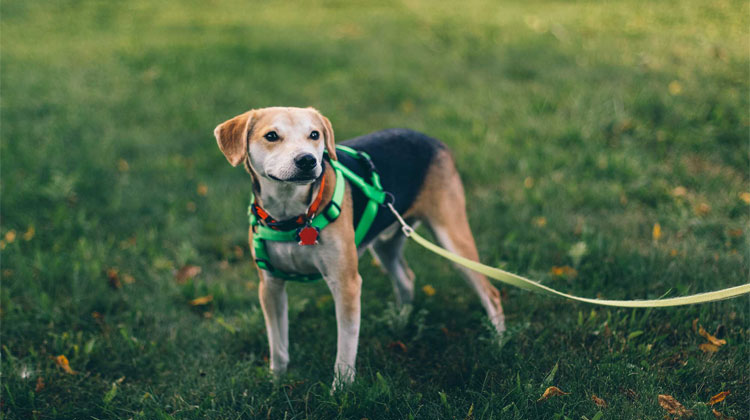
Dog collars are a common way to both identify a dog and keep him under control when he is out on walks. Harnesses are less common but actually provide many benefits over collars.

Both options are acceptable choices for most dog breeds but a few, like pugs, require a harness due to their anatomy. When deciding between a collar or harness for your dog, consider all of these factors in your decision.
Read More:
- Reasons a Harness Will Stop your Dog from Pulling
- how to choose the right collar for your dog
- Why You Should Choose a Dog Harness Over a Collar | Harness vs Collar
- Dog Harness vs Collar | Which Is Best For Your Dog?
- Things To Consider When Choosing Adventure Gear For Dogs
Breed
Some dogs are classified as brachycephalic. This is just a complicated way to say that they have short, smashed faces. Examples of these breeds include pugs, bulldogs, boxers, Boston terriers, and Shih Tzus. Because of the shape of their heads, collars easily pull off of these dogs and don’t stay in place. More importantly, a collar can be as dangerous as it is inconvenient on these breeds. Brachycephalic dogs tend to have shallow eye sockets, so pulling on the back of their heads with a collar can cause an eye to pop out of the socket. These dogs also tend to have compromised airways which are further restricted by collars. If you have a brachycephalic breed, always opt for a harness rather than a collar.
Control
When it comes to controlling your dog, a harness is the better option. If you pull one way and your dog the other, tugging his leash when he is wearing a collar puts pressure on his trachea. This can interfere with his breathing, cause a coughing fit and potentially harm the dog’s throat. A harness, however, enshrouds the dog’s entire mid-section, safely giving you more control over him. If you have to hold your dog back in a harness, the device lets you exert pressure on the bulkiest part of the animal rather than on the most delicate. You have a firmer hold and a reduced risk of accidentally hurting your dog.
Ease Of Use
There is no question that a collar is easier to use than a harness. You can place a collar around your dog’s neck and leave it there all the time. Other than letting the collar out a bit as the dog grows, a collar is a maintenance-free option. Harnesses, however, require some effort to get on the dog and they are put on and taken back off as part of every walk or outing. This can be a challenge if your dog dislikes his harness and resists it when you try to put it on.
Visibility
Both collars and harnesses are available in bright colors to increase your dog’s visibility. Both are also available with reflective properties and lights for nighttime use. Again, the harness is superior to the collar. A collar is smaller than a harness and has less surface area, making it harder to see. An illuminated collar is better than nothing when your dog is out at night, but an illuminated harness is better still.
Comfort
Comfort is another arena in which a traditional dog collar shines. Collars are small and unobtrusive, so most dogs don’t object to wearing one. Harnesses, however, are larger, more involved, and more uncomfortable for the wearer. Your dog may just need some time to get used to his harness. If time doesn’t help, try a few harness styles and materials. Some clip in the front while others clip in the back. Finding the right harness may require some trial and error. If you have a dog that doesn’t need a harness for breed anatomical reasons, it might be easier to simply use a collar.
Assistance Level
Older dogs sometimes experience arthritis and other health problems. Though they may still enjoy a walk, seniors may need to take periodic breaks. If so, a little help to get them standing again may be appreciated. If your dog is wearing a collar, you’ll need to bend down and give him a lift in order to help. If your dog is in a harness, however, a bit of gentle lifting on the leash from you will help him stand.
So long as your dog has no special needs that make a collar dangerous for him, either a collar or a harness is an acceptable option. Both have pros and cons, so you’ll have to decide which one is right for you and your dog. It’s quite likely, however, that a harness will work best.
Popular Post



